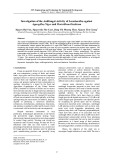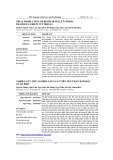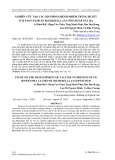
Vietnam Journal
of Agricultural
Sciences
ISSN 2588-1299
VJAS 2023; 6(4): 1924-1930
https://doi.org/10.31817/vjas.2023.6.4.03
https://vjas.vnua.edu.vn/
1924
Received: April 27, 2023
Accepted: October 26, 2023
Correspondence to
vhcong@vnua.edu.vn
ORCID
Vo Huu Cong
https://orcid.org/0000-0002-3356-
5791
Evaluation of Electricity Generation from
Wastewater by Microbial Fuel Cell
Vo Huu Cong*, Tran Duc Vien & Ho Thi Thuy Hang
Faculty of Natural Resources and Environment, Vietnam National University of
Agriculture, Hanoi 131000, Vietnam
Abstract
Combined systems for wastewater treatment and resource recovery
have been developed in many countries. However, systems for
energy generation are still underdeveloped. This research was
conducted to evaluate the possibility of electric potential generation
from wastewater using a microbial fuel cell system (MFC). The
simple two-chamber apparatus (2 liters) was fed with wastewater
collected from dormitory discharge. Three batch experiments were
carried out with 2 liters of wastewater with an influent concentration
of 518 mg L-1 BOD5 and 750 mg L-1 COD. The results showed that
the microbial fuel cell system generated a potential from 0.29 to 0.45
V for 7 days in the presence of 1.0-1.5% (v/v) Bacillus subtilis while
this potential was not obtained in the case when microbes were not
added. The highest removal efficiencies of BOD5 and COD reached
56% and 63%, respectively. It was found that the potential dropped
to almost zero in all of the treatments while the ratio of BOD:COD
was 0.83 and the concentration of BOD was around 230 mg L-1,
indicating that other governing factors may have an impact on
potential electricity generation. Therefore, further studies on the
effects of the operating conditions and equipment should be
comprehensively studied.
Keywords
Microbial fuel cell, domestic wastewater, renewable energy,
electricity generation, Bacillus subtilis
Introduction
In Vietnam, it has been reported that domestic wastewater
generated throughout the country has significantly increased, with
Hanoi and Ho Chi Minh City reaching approximately 900,000 m3
day-1 and 2.67 million m3 day-1, respectively (Ministry of Natural
Resources and Environment, 2016). However, municipal wastewater
treatment plants only process 14% of the total amount generated, and
up to 86% of untreated urban wastewater is directly discharged into
the environment (World Bank, 2013). A general characteristic of

Vo Huu Cong et al. (2023)
https://vjas.vnua.edu.vn/
1925
domestic wastewater is that it often contains
many organic substances and nutritional
components such as nitrogen, phosphorus, and
pathogenic microorganisms (Son et al., 2020).
The large amounts of wastewater discharged into
the environment have significant impacts on the
receiving source but recoverable resources could
be extracted from the wastewater. Domestic
wastewater discharges in rural areas are
commonly mixed with livestock wastewater, and
therefore contain significant amounts of nitrogen
and have a high biochemical oxygen demand
(BOD) (Vo Huu Cong & Phung Thi Hang, 2019).
On the other hand, domestic wastewater
treatment focuses on the application of
biochemical and chemical technologies to
minimize the concentration of pollutants but does
not yet incorporate energy recovery technologies
into the treatment system.
Microbial fuel cells (MFCs) are bio-
electrochemical systems capable of degrading
organic compounds through microbial activities,
while simultaneously releasing electrons (e-) and
protons (H+), thereby generating electricity
(Pandit & Das, 2018). The initial application of
MFCs was to decompose glucose in an aqueous
solution using Escherichia coli and obtain an
electric potential of 500mV at 1000ohms (Ω) for
1 hour (Davis & Yarbrough, 1962). In the 1980s,
several researchers discovered that adding
electron mediators could enhance the current
density and power output (Vega & Fernández,
1987; Allen & Bennetto, 1993; Park & Zeikus,
2000; Ikeda & Kano, 2003; Ieropoulos et al.,
2005). During the early stages of MFC research
and development, much effort was paid to the
investigation of microbes, substrates, and the
configuration of electrode materials. It was
reported that the microorganisms capable of
transferring electrons directly to the anode stably
and highly efficiently without electron mediators
were Shewanella putrefaciens (Kim et al., 1999),
Geobacteraceae sulferreducens (Bond &
Lovley, 2003), Rhodoferax ferrireducens
(Chaudhuri & Lovley, 2003), and Geobacter
metallicireducens (Min et al., 2005). Substrates
play an important role in the system as carbon
sources. In addition to glucose, starch, substrates
such as lactate, molasses (Niessen et al., 2004),
acetate, and sucrose (Park & Zeikus, 2000) have
all been studied. The concept of bioelectricity has
been used commonly when culturing
Escherichia coli and Saccharomyces on platinum
electrodes (Du et al., 2007). Since then, there
has been a significant increase in the
application of MFCs technology for renewable
energy, especially, the generation of electricity
from wastewater.
For the application of an MFC system, it is
important to use strong and affordable microbial
strains. The aerobic Gram-positive species
Bacillus subtilis, for example, is able to grow
anaerobically and produce a biofilm in a
microbial fuel cell, which can generate long-term
power output. This species is one of the most
commonly used hosts in fermentation
production. It is also simple to cultivate and
compatible with various culturing environments
(Nimje et al., 2009).
The research on microbial fuel cell systems
in Vietnam has focused on selecting electrode
materials for MFCs and using biosensors in
assessing water quality (Nong Minh Tuan, 2014).
However, these findings are covered in the field
of biosensors. Other research has focused on the
effects of chloride on the performance of
microbial fuel cells for wastewater treatment
(Duyen et al., 2021). Recently developed
microbial fuel cell systems can be catalyzed by
various microbial strains. It was reported that an
MFC inoculated with Bacillus subtilis generated
a potential of 0.45V against an external
resistance of 125Ω (Ismail & Jaeel, 2013), or a
maximum voltage of 0.52V with a 5%
concentration of glucose (Yoganathan & Ganesh,
2015). This research was conducted to assess the
electricity generated from domestic wastewater
employing a simple design of an MFC and to
evaluate the possibility of organic matter
reduction via the electricity generation process.
Methodology
Wastewater
The wastewater and water samples for the
experiment were collected and analyzed
following the national standard methods for
water analysis (TCVN 6663-1:2011).

Evaluation of electricity generation from wastewater by microbial fuel cell
1926
Vietnam Journal of Agricultural Sciences
Wastewater was collected at the discharge point
from the dormitory of a university in suburban
Hanoi. Wastewater was then separated for the
experimental run and initial conditions analysis.
The water quality parameters, namely pH, TSS,
BOD5, COD, NO3-, PO43-, and coliform, were
analyzed and compared with the national
regulations for domestic wastewater quality
(QCVN14-MT:2015).
The water samples were collected from the
chamber with a syringe (50mL). The pH values
were measured by a portable pH meter;
biological oxygen demand (BOD5) was
measured following TCVN 6001- 1:2008 (ISO
5815-1:2003) - determination of biochemical
oxygen demand after n days (BODn); chemical
oxygen demand (COD) was measured following
TCVN 6491:1999 (ISO 6060:1989) -
determination of the chemical oxygen demand;
total suspended solids (TSS) were measured
following SMEWW 2540 water quality -
determination of TSS; nitrate (NO3-) was
measured following TCVN 7323-2:2004 water
quality - determination of nitrate; phosphate
(PO43-) was measured following TCVN
6202:2008 water quality- determination of
phosphorus; and coliform was counted
following TCVN 6187-1:2009 water quality -
detection and enumeration of Escherichia coli
and coliform bacteria.
Experimental apparatus
The microbial fuel cell was designed as a two-
chamber MFC system with each chamber holding
2000mL. The cathode chamber was fed with tap
water whereas the anode chamber was fed with
domestic wastewater. To facilitate the proton
exchange, the anode and cathode chambers were
connected by a 3% KCl salt bridge through a
cylindrical pipe with a diameter of 2cm and a
length of 7cm. Each chamber was fixed with a
graphite electrode (2cm × 2cm × 0.5cm). This size
was suitable with the size of the electrodes’ surface
area. The graphite electrodes were connected
through a Victor VC 890D potentiometer for
potential measurement (Figure 1).
Experimental operation conditions
This research was conducted in a batch
experiment in anaerobic conditions with three
runs (Table 1). The Bacillus subtilis strain was
selected as the catalyst for the biological
conversion of organic contents because it has
been reported as having a high potential for
bioelectricity generation (Nimje et al., 2009;
Ismail & Jaeel, 2013). In this study, a pure
Bacillus subtilis inoculant was provided by the
Department of Microbiology (VNUA). The
Bacillus subtilis was propagated at level 1 in a
specialized environment (0.4g meat broth, 1g
peptone, 0.5g NaCl, 2g jelly, and 100mL distilled
water) in the laboratory. The original amount of
culture inoculant was 11.1 x 1010 (CFU/100mL).
The voltage produced by the MFCs was
measured with a Victor VC 890D meter at 0, 6,
24, 30, 48, 54, 72, 78,… hours until the
potential approached zero. The BOD5 and COD
were measured before and at the end of each
batch experiment.
Figure 1. Experimental apparatus. A1, A2, and A3 represent the anode chambers of CT0, CT1, and CT2, respectively;
C represents the cathode chamber
A1
C
C
C
A2
A3

Vo Huu Cong et al. (2023)
https://vjas.vnua.edu.vn/
1927
Table 1. Experimental operation conditions
Run
Treatment volume
Supplement of microbe
CT0- Control
2000mL
No addition of microbe
CT1
2000mL
1.0% (v/v) of Bacillus subtilis
CT2
2000mL
1.5% (v/v) of Bacillus subtilis
Results and Discussion
Wastewater characterization
The wastewater generation was estimated at
62-75 liters/person/day and was collected from a
dormitory of 10,000 students. Table 2 shows the
wastewater quality via pH, BOD5, TSS, COD, N-
NO3-, P-PO43-, and coliform. The initial
concentration of COD was observed at 750 mg
L-1 and the concentration of BOD5 was 518 mg
L-1. The COD concentration was about six times
higher than that of the limited value (125 mg/L)
regulated by QCVN 14-MT:2015/BTNMT
(category B - limit of the regulated value for the
discharge of wastewater into a receiving water
body not used for domestic water recycling
purposes). The BOD concentration was also
almost ten times higher compared to the upper
limit of the regulated values. These results are
similar to the general characteristics of the
organic content in domestic wastewater
published elsewhere (Hoa, 2017). The
concentrations of N-NO3- and P-PO43- were still
within the permitted limits of QCVN 14-
MT:2015. It was obtained that the concentration
of coliforms was 133,630 CFU/100 mL, much
higher than the regulation value (5000
CFU/100mL).
In wastewater treatment with indication for
resources recovery or energy recovery, the COD
and BOD are components indicating the potential
for microbial degradation and are associated with
electricity generation. In this research, the ratio
of BOD/COD was 0.69, indicating a high level
of biodegradable organic contents. The proper
ratio of BOD:N:P is necessary to maintain
suitable conditions for aerobic or anaerobic
treatment by microorganisms. The optimal ratio
for BOD:N:P has been reported at 100:5:1 for
aerobic digestion and 350:5:1 for anaerobic
digestion. In this research, the ratio of BOD:N:P
of the domestic wastewater was 77:0.1:1.
Electricity generation efficiency
The efficiency of electricity generation was
assessed by the voltage produced during the time
course changes of the MFC’s operation. The
results of 216 hours of operation show that the
presence of B. subtilis bacteria increased
electricity production compared to that of water
without supplementation (CT0) (Figure 2).
When the contents of B. subtilis were increased
from 1% (v/v) (CT1) to 1.5% (v/v) (CT2), the
voltage appeared and increased earlier and was
maintained after 32 hours (from 36 to 168 hours).
In formula 1 (CT1) with 1% of B. subtilis, the
voltage was almost zero during the first 24 hours.
The potential appeared from 30-54 hours after
the operation began, then sharply increased and
reached peak value (0.44V) after 78 hours.
However, the potential decreased substantially to
around 0.265V at 150 hours then continued its
downward trend to roughly 0.091V at 168 hours.
The control formula without supplemental B.
subtilis indicated that the voltage was nearly
below the detection value of the device. When
the content of B. subtilis was set at 1.5% (v/v),
the electric potential appeared quite early, within
6 hours of the beginning of the operation. The
potential was maintained around 0.3-0.4V for
168 hours, then decreased at the time similar to
treatment 1. The potential obtained in this
research was similar to that reported in other
research papers (Nimje et al., 2009; Ismail &
Jaeel, 2013) when B. subtilis was added to
generate a higher and more stable electric
current. In another research article (Liu et al.,
2011), when operating an MFC system with
domestic wastewater with a COD of 415 ± 50 mg
L-1, the generated electricity remained stable
after 270 hours to reach more than 200mV and
continued to generate electricity until the end of
the experiment for 1200 hours. It was observed
that the potential reaching zero within 200 hours

Evaluation of electricity generation from wastewater by microbial fuel cell
1928
Vietnam Journal of Agricultural Sciences
Table 2. Characteristics dormitory wastewater
No.
Indicator
Unit
Measured value
QCVN 14-MT: 2015 (B)
1
pH
-
7.07
5-9
2
BOD5
mg L-1
518
50
3
TSS
mg L-1
76
100
4
COD
mg L-1
750
150
5
N-NO3-
mg L-1
0.49
50
6
P-PO43-
mg L-1
6.68
10
7
Coliforms
CFU 100mL -1
133,630
5,000
Figure 2. Electricity generation within 216 hours. CT0 is the control experiment without added B. subtilis, CT1 is the treatment with
1.0% B. subtilis, and CT2 is the treatment with 1.5% B. subtilis (v/v).
of all operations may indicate the limitations
of the operating conditions in regards to
organic contents (carbon source), nutrients
(N, P), or microbes.
The observed data may indicate that without
adding a microbial strain, less potential is
produced by the microbial fuel cell regardless of
the existence of an indigenous microbial
community in the wastewater. Adding a
microbial strain showed a potential up to 0.4V.
The reduction of potential after 200 hours may
have been due to the weakening of the microbial
strain due to detergent from washing activities.
Therefore, further studies should be conducted
with wastewater from other sources and under
different operating conditions.
Figure 3 shows the potential use of domestic
wastewater as carbon sources for biodegradation
to produce electric potential by a microbial fuel
cell. It was obtained that an electric potential was
generated while the concentration of the organic
content declined significantly. The
concentrations of the BOD5 and COD values
represent a downward trend in all of the
formulas. The obtained removal efficiencies
were 34%, 49%, and 56% for BOD5 in CT0,
CT1, and CT2, respectively. The COD removal
efficiency also reached the highest efficiency in
CT2, with 63% of the COD content removed
after 216 hours. These results are similar to the
research by Min and Logan (2004), who treated
domestic wastewater with flat plate MFC. The
COD treatment efficiency ranged from 42-79%
when the retention time and flow capacity were
changed, and electricity was generated reaching
7.2 ± 1 mW m-2 to 43 ± 1 mW m-2.
0.00
0.10
0.20
0.30
0.40
0.50
050 100 150 200
Potential (V)
Time (hours)
CT0 CT1 CT2



![Đề cương môn Vi sinh vật thú y [chuẩn nhất]](https://cdn.tailieu.vn/images/document/thumbnail/2025/20250414/trantrongkim2025/135x160/1263896842.jpg)






















